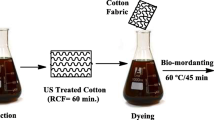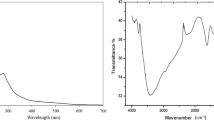Abstract
Natural products particularly natural colorants have attained worldwide importance and being eco-friendly can be considered an alternative to toxic dyes in order to reduce environmental pollution. The current study is based on the exploration of natural coloring behavior of bitter gourd leaves extract for cotton dyeing. Colorant was extracted using different extraction media like aqueous, alkali, organic, and acidic at different conditions. It has been found that on application of 50 ml of acidic extract having 6 g/100 ml of table salt for 55 min at 60 C°, maximum color yield has been obtained onto cotton. Upon using chemical and bio-mordants, new shade with good color fastness rating was obtained. FTIR analysis of extract showed the presence of flavonoids. It is concluded that under mild condition, bitter gourd leaves extract can be considered potential source of natural colorant for cotton dyeing and the presence of bio-mordant has made the process more soothing and sustainable in nature.





Similar content being viewed by others
Data availability
The work is from PhD studies.
References
Adeel S, Kiran S, Shahid M, Habib SR, Habib N, Hussaan M (2021a) Ecofriendly application of coconut coir (Cocos nucifera) extract for silk dyeing. Environ SciPollut Res 1–9.https://link.springer.com/article/https://doi.org/10.1007/s11356-021-15669-6
Adeel S, Rehman, F, Pervaiz M, Hussaan M, Amin N, Majeed A, Rehman H (2021b) Microwave assisted green isolation of laccaic acid from lac insect (Kerria laca) for wool dyeing. Progress in Color, Colorants and Coatings 14(4):293–299
Ajmal M, Adeel S, Azeem M, Zuber M, Akhtar N, Iqbal N (2014) Modulation of pomegranate peel colourant characteristics for textile dyeing using high energy radiations. Ind Crops Prod 58:188–193
Anand DC, Mishra P, Patni V (2018) Quantitative evaluation of plant metabolites and dye extraction from leaves of Ampelocissus latifolia (Roxb.) planch. J Pharmacogn and Phytochem7(4):2260–2264
Arain RA, Ahmad F, Khatri Z, Peerzada MH (2021) Microwave assisted henna organic dyeing of polyester fabric: a green, economical and energy proficient substitute. Nat Prod Res 35(2):327–330
Arifeen, W, Rehman F, Adeel, S, Zuber M, Ahmad, MN, Ahmad T(2021).Environmental friendly extraction of walnut bark-based juglone natural colorant for dyeing studies of wool fabric.Environ SciPollut Res. 28 (36): 49958–49966.
Baaka N, Haddar W, Ben Ticha M, Amorim MTP, M’Henni MF (2017) Sustainability issues of ultrasonic wool dyeing with grape pomacecolourant. Nat Prod Res 31(14):1655–1662
Baliarsingh S, Panda AK, Jena J, Das T, Das NB (2012) Exploring sustainable technique on natural dye extraction from native plants for textile: identification of colourants, colourimetric analysis of dyed yarns and their antimicrobial evaluation. J Clean Prod 37:257–264
Batool F, Adeel S, Azeem M, Iqbal N (2022) Natural dye yielding potential and compounds of selected vegetable residues belonging to Brassicaceae: an approach towards sustainability. Pak J Bot 54(1): https://doi.org/10.30848/PJB2022-1(39)
Batool F, Iqbal N, Azeem M, Adeel S, Ali M (2019) Sustainable dyeing of cotton fabric usingblack carrot (Daucus carota L.) plant residue as a source of natural colorant. Pol J Environ Stud 28(5):3081–3087
Dhahri H, Guesmi A, Hamadi NB (2019) Application of phenolic compounds as natural dye extracted from date-pits: dyeing studies of modified acrylic fibres. Nat Prod Res 33(9):1329–1333
Dhouibi N, Ticha MB, Raddaoui H, Boudokhane C, DhaouadiH(2021) Valorization and reuse of Centaurea Kroumeriensis hydrodistillation effluent: a sustainable phytodyeing process for wool fabrics. Fibers Polym22:2238:2250
Dulo B, Phan K, Githaiga J, Raes K, Meester DS (2021) Natural quinone dyes: a review on structure, extraction techniques, analysis and application potential. Waste and Biomass Valoriz 1–36. https://link.springer.com/article/https://doi.org/10.1007/s12649-021-01443-9
Giacomini F, Menegazzo MAB, dos Santos JCO, Arroyo PA, de BarrosMASD, (2017) Ecofriendly dyeing of silk with extract of yerba mate (Ilex paraguariensis). Text Res J 87(7):829–837
HabibN AS, Ali F, Amin N, Khan SR (2021) Environmental friendly sustainable application of plant-based mordants for cotton dyeing using Arjun bark-based natural colorant. Environ SciPollut Res 28(38):54041–54047
Hosen MD, Rabbi MF, Raihan MA, Al MamunMA(2021) Effect of turmeric dye and biomordants on knitted cotton fabric coloration: a promising alternative to metallic mordanting. Clean EngTechnol3:100124
Islam S, Sun G (2017) Thermodynamics, kinetics, and multifunctional finishing of textile materials with colorants extracted from natural renewable sources. ACS Sustain ChemEng5(9):7451–7466
Kasiri MB, Safapour S (2014) Natural dyes and antimicrobials for green treatment of textiles. Environ ChemLett 12(1):1–13
Kenny O, Smyth TJ, Hewage CM, Brunton NP (2013) Antioxidant properties and quantitative UPLC-MS analysis of phenolic compounds from extracts of fenugreek (Trigonella foenum-graecum) seeds and bitter melon (Momordica charantia) fruit. Food Chem 141(4):4295–4302
Khan AA, Adeel S, Azeem M, Iqbal N (2021) Exploring natural colorant behavior of husk of durum Triticum durum Desf. and bread Triticum aestivum L. wheat species for sustainable cotton fabric dyeing. Environ SciPollut Res28(37): 51632–51641
Kubola J, SiriamornpunS(2008) Phenolic contents and antioxidant activities of bitter gourd (Momordica charantia L.) leaf, stem and fruit fraction extracts in vitro. Food Chem110(4):881–890
Liu J, Li W, Kang X, Zhao F, He M, She Y, Zhou Y (2021) Profiling by HPLC-DAD-MSD reveals a 2500-year history of the use of natural dyes in Northwest China. Dyes Pigm187:109143
Madala NE, Piater L, Dubery I, Steenkamp P (2016) Distribution patterns of flavonoids from three Momordica species by ultra-high performance liquid chromatography quadrupole time of flight mass spectrometry: a metabolomic profiling approach. Rev Bras Farmacogn 26:507–513
Naqvi SAR, Ali S, Sherazi TA, Haq AU, Saeed M, Sulman M, Abdel-Daim MM (2020) Antioxidant, antibacterial, and anticancer activities of Bitter Gourd fruit extracts at three different cultivation stages. J Chem 55:1–10
Poolperm S, Jiraungkoorskul W (2017) An update review on the anthelmintic activity of bitter gourd, Momordica charantia. PharmacognRev 11(21):31
Pucciarini L, Ianni, F, Petesse V, Pellati F, Brighenti V, Volpi C, Gargaro M, Natalini B, Clementi C, Sardella R (2019) Onion (Allium cepa L.) skin: a rich resource of biomolecules for the sustainable production of colored biofunctional textiles. Molecules 24 (3): 634–644
Saeed F, Afzaal M, Niaz B, Arshad MU, Tufail T, Hussain MB, Javed A (2018) Bitter melon (Momordica charantia): a natural healthy vegetable. Int J Food Prop 21(1):1270–1290
Shabbir M, Islam SU, Bukhari MN, Rather LJ, Khan MA, Mohammad F (2016) Application of Terminalia chebula natural dye on wool fiber, evaluation of color and fastness properties. Text Cloth Sustain 2(1):2–9
Shahid M, Zhou Y, Tang RC, Chen G, Wani WA (2017) Colourful and antioxidant silk with chlorogenic acid: process development and optimization by central composite design. Dyes Pigm 138:30–38
Tan ES, Abdullah A, KassimNK(2015) Extraction of steroidal glycoside from small-typed bitter gourd (Momordica charantia L.). J Chem Pharm Res 7(3):870–878
Vatas D, Morya S (2021) Bitter gourd an exceptional crop: a review focuses on nutraceutical and pharmaceutical properties. Pharm Innov J 10(5):1001–1006
Velmurugan P, Shim J, Seo SK, Oh BT (2016) Extraction of natural dye from Coreopsis tinctoria flower petals for leather dyeing−An eco-friendly approach. Fibers Polym 17(11):1875–1883
Yılmaz F, Bahtiyari MI (2020) Antibacterial finishing of cotton fabrics by dyeing with olive tree leaves fallen during olive harvesting. J Clean Prod270:122068
Zhang Y, Zhou Q, Rather LJ, Li Q (2021) Agricultural waste of Eriobotrya japonica L. (Loquat) seeds and flora leaves as source of natural dye and bio-mordant for coloration and bio-functional finishing of wool textile. Ind Crops Prod 169:113633
Zia KM, Adeel S, Rehman F, Aslam H, Khosa MK, Zuber M (2019) Influence of ultrasonic radiation on extraction and green dyeing of mordanted cotton using neem barkextract. J Ind Eng Chem 77:317–322
Acknowledgements
We greatly acknowledged the Vegetable Section of Ayub Agricultural Research Institute Faisalabad, Pakistan, for providing bitter gourd residual material to conduct a part of the PhD studies of Ms. Fatima Batool.
Author information
Authors and Affiliations
Contributions
Dr. Naeem Iqbal is the supervisor, where Dr. Shahid Adeel and Dr. Muhammad Azeem have guided scientifically for smooth running of the work. Dr. Fatima Batool has performed the work, where Muhammad Hussaan has helped in assessment of data and experiments.
Corresponding author
Ethics declarations
Ethical approval
We approve that this manuscript is part of PhD studies.
Consent to participate and publish
We give consent to publish our work of PhD studies and is jointly contributed by all authors.
Competing interests
The authors declare no competing interests.
Additional information
Responsible Editor: Philippe Garrigues
Publisher's Note
Springer Nature remains neutral with regard to jurisdictional claims in published maps and institutional affiliations.
Rights and permissions
About this article
Cite this article
Batool, F., Adeel, S., Iqbal, N. et al. Sustainable natural coloring potential of bitter gourd (Momordica charantia L.) residues for cotton dyeing: innovative approach towards textile industry. Environ Sci Pollut Res 29, 34974–34983 (2022). https://doi.org/10.1007/s11356-021-17803-w
Received:
Accepted:
Published:
Issue Date:
DOI: https://doi.org/10.1007/s11356-021-17803-w




